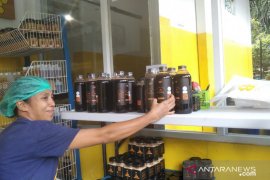South Sumatra is one of the provinces in the country that is considered capable of contributing to the greenhouse emissions reduction target because it has an expanse of forest, peat, and mangroves, which are still in good condition, acting director general of forestry planning and environmental management at the ministry, Ruandha Agung Sugardiman, said.
"It's just a matter of handling forest and land fires; if they can be suppressed until they don't exist, they will greatly contribute," he added after delivering a lecture at the “Information Dissemination of Sub-National Indonesia's Forestry and Other Land Use 2030 Net Sink” in Palembang on Wednesday.
He said the Paris Agreement requires Indonesia to describe and communicate post-2020 climate resilience actions in the Nationally Determined Contributions document and submit it to the Secretariat of the United Nations Framework Convention on Climate Change (UNFCCC).
As per the Nationally Determined Contributions (NDC) document, Indonesia is targeting to reduce greenhouse gas emissions by 29 percent by 2030 through its own efforts and 41 percent with international support.
South Sumatra has become an important province for focusing efforts to achieve the national target because it is still plagued by forest and land fires.
Sugardiman said, Indonesia did not want to be taken as a country sans commitment during the formulation of the Paris Agreement because it would be easy for the United Nations to assess the extent of the commitment based on satellite imagery.
Therefore, the Environment and Forestry Ministry formulated a work plan for pursuing the 2030 zero emission target at all levels, which requires active contribution from regional governments.
So far, Indonesia has been named as one of the countries most committed to reducing greenhouse gas emissions.
Two countries, namely the United States and Britain, have shown greater interest than other countries in providing funding to Indonesia to meet that end.
Indonesia is considered capable of achieving the zero emissions target by 2030 because it is also putting in other efforts besides handling forest and land fires, such as planting trees, maintaining forest areas, and restoring peat and mangrove areas.
"Regarding forest and land fires, South Sumatra is asked to be committed because if the incident grew even more severe, it is not impossible that donor countries will withdraw their commitments (41 percent of international support)," Sugardiman said.
According to head of the South Sumatra Forestry Office, Pandji Tjahjanto, South Sumatra’s forest area spans 3.4 million hectares and makes up 36 percent of the total area of the province.
He said that since the great forest fire in 2015, South Sumatra has continuously made improvements in handling forest and land fires.
Six years after the 2015 fire, the trend of forest and land fires in South Sumatra has continued to decline, he noted. Further, tree plantation and peat management improvements have been undertaken, both for protected peat and cultivated peat.
A member of Commission IV of the House of Representatives in South Sumatra, Riezky Aprilia, said that her party has continued to follow the greenhouse emission reduction program in terms of fund allocation from the state budget.
At least Rp200 trillion is needed to achieve the zero carbon target by 2030, so cooperation from the relevant ministries and institutions is necessary to meet the target set by the government.
"Of course, we will prioritize cooperation with Commission IV partners, starting from the Environment and Forestry Ministry, the Agriculture Ministry, and the Maritime Affairs and Fisheries Ministry first," Aprilia added.
Related news: Forest, land fires most common disasters last week: BNPB
Related news: 3 districts chosen for cluster-based forest fire prevention pilot
Related news: Kemitraan encourages cluster approach in preventing forest, land fires
Translator: Dolly Rosana, Mecca Yumna
Editor: Sri Haryati
Copyright © ANTARA 2022











